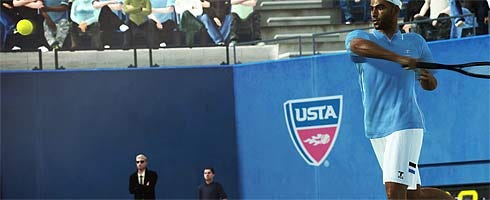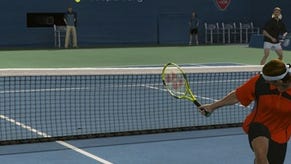Hands-on with Top Spin 4 – the tennis game that’s too complex for Kinect
Thinking about it for a second, tennis games have a weird tendency to be at the forefront of revolution in the videogames industry. The first proper commercial videogame was a tennis game. Virtua Tennis was a Dreamcast poster child. Tennis games were some of the first to really embrace online. And many of the first motion control game were tennis games – Wii MotionPlus launched with two of them.
According to 2K Czech President Stephane Dupas, Top Spin 4 marks the point at which motion control has become sophisticated enough to satisfy the series’ simulation needs – on Sony’s hardware, anyway. We spent some time with Dupas and the game in London recently – read our impressions below.
Top Spin 3, says 2K, was the most successful tennis game ever in terms of sales. Admittedly it was released on about nine platforms, but still, that’s an achievement, especially for a game that’s much closer to a sports simulation than the cheap and cheerful, super-accessible spin that rival publishers often put on the sport.
Dupas reckons that Top Spin’s complexity is the very thing that makes it successful. “It’s got the right combination of varied, realistic animation and behaviour, level of accessibility and depth. You have a lot of tennis games recently, especially with the new [motion] interface, that want to be accessible after 30 seconds or 5 minutes; we’ve always tried to do a genuine tennis sim. That’s our main strength.”
Despite that determination to do tennis justice as a sport, it’s undeniable that Top Spin has been off-putting in its complexity in the past, and the developer clearly realises that. Top Spin 4 aims to be more accessible without compromising on depth, or betraying those simulation sensibilities that have made it stand out from the crowd.
Risk shots – once mapped to a trigger – are now gone, replaced with a simpler system of single taps for lighter, angled hits and long presses for power. Immediately, the game uses less of the buttons at once – but the underlying depth is preserved. Top Spin 4 is a complicated game, but it’s making an effort to explain itself better.
Indicative of this approach is a new selection of on-screen prompts that make the hidden machinations of Top Spin’s simulation more visible. The team found that players of previous games in the series were often failing without really understanding why; now a timing helper, taking the form of a little circle next to your player, shows you the right moment to release the button to place the shot perfectly. A fatigue bar shows a player’s state of readiness, and there’s a small cross indicating where the first bounce will land.
All of these prompts can be turned on or off in the menu, but at least for the first few games, they really help you to understand exactly why your shots are soaring gracefully towards the baseline or pinging off at wild angles and going straight out. Before, this was mostly down to instinct, developed over hours’ worth of career practice and throwing controllers at housemates/pets in fits of impotent rage.
The Top Spin Academy tutorial system was also crucial to developing an understanding of exactly how the game worked – and it still will be. It now offers guidance on playstyles and strategy, too, teaching you what it means to be an offensive baseline or serve and volley player and helping you to learn which attributes are most important to your style of play.
There’s been a revamp of the career system that at first seems to make things much more complicated, but ultimately makes a player’s development more realistic. Instead of putting points into a individual skills, every level of experience now gives a points pack that improves technique.
Choose defensive baseline, for instance, and your speed, forehand and backhand will go up; offensive baseline concentrates on power and serve. You can’t build an omnitalented super-player, but you can build one that’s exceptionally talented in a particular area.
Coaches – another new addition – add extra bonus points to a player’s abilities, allowing you to tweak your skills slightly by picking a coach that matches your strengths or weaknesses. They also come with coach skills that work rather like perks.
There are other technical additions, like an advanced serve system that lets you control ball placement with the right stick rather like you control your swing in a golf game, but I’m beginning to sound a bit like a press release, so I won’t list them. The point is that Top Spin 4 certainly isn’t oversimplifying things – if anything, it’s still a bit overwhelming.
Given this level of detail, it’s perhaps surprising that 2K Czech has opted to incorporate motion control at all. Top Spin 4 only supports Move because, Dupas claims, it’s the only motion controller with the required precision. “For the first time, we’ve found something that’s as precise as it is with a normal controller,” he says.
“Our first goal with the motion control was to make it fit with the game design, not to change the game because of the controller. And fortunately for us, Move is a good accessory, it’s very precise, so we were able to remap all the core controls that we have, making sure that if somebody with Move is playing somebody with a pad, it’s a fair contest.”
Frustratingly, we didn’t get to actually play with the Move at all, so we’re going to have to take his word for it for now. But it’s easy to see how the sub-controller makes tennis with Move a less frustratingly random experience than Wii Sports Tennis or, presumably, Kinect.
“It’s true that you need to keep the stick to move your character around in order to keep the balance of the game,” agrees Dupas. “So Kinect is more difficult, because to move your character around with Kinect is impossible.”
Top Spin 4 is remaining true to itself, treating a very mainstream subject with impressive dedication. “Other games say, ‘Tennis is very mainstream, so we’re going to do it very simply so that we can have a small percentage of the big casual market’,” says Dupas. “It’s a very valid, relevant and honest approach. But it’s not ours. Ours is a different idea.”





